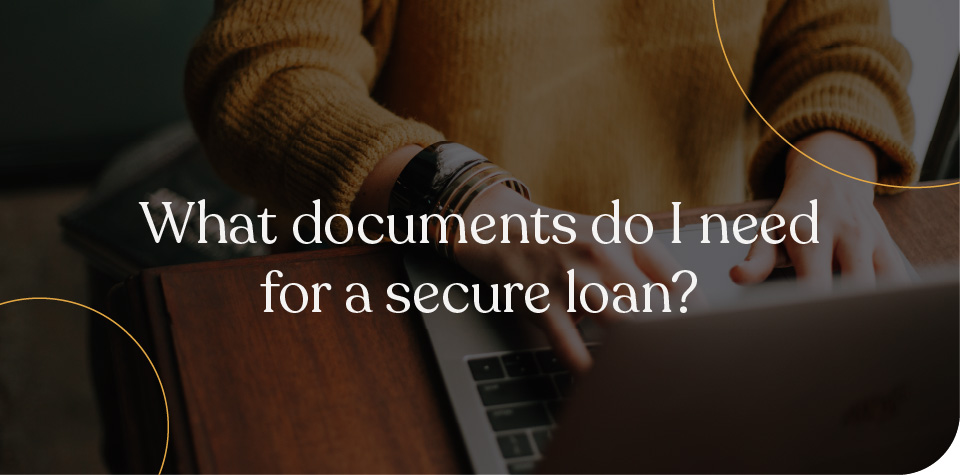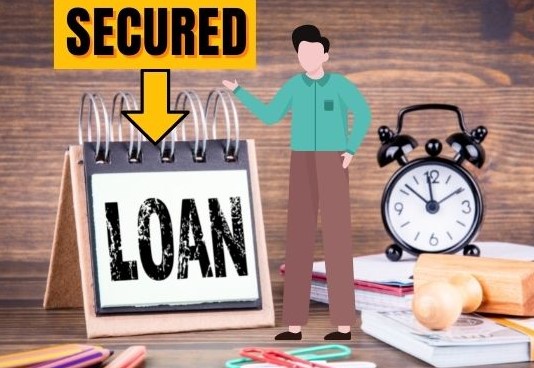
If you need to remodel your home, consolidate debts, scale your business, or even pay for your child’s college education, you’ll need cash – a lot of it. You could apply for a personal loan, but chances are, the loan amount you qualify for won’t be nearly enough to cover the associated costs.
Moreover, if you have bad credit, you’ll have trouble getting approved for an unsecured loan.
Secured loans are a common alternative for prospective borrowers who need larger loan amounts or whose poor credit history makes it difficult to qualify for personal loans. As long as you own a valuable asset, such as property or vehicles, you can use it as collateral to secure the debt.
What documents do I need for a secured loan, and how quickly can I get it? This guide explores the answers to these questions and more.
Get started onlineJump to:
- What is a secured loan?
- What documents do I need when applying for a secured loan?
- What documents are required for collateral?
- Can you get a secured loan before paying off your mortgage?
- How long does loan approval take?
- Get help from a qualified bad credit loans expert
- FAQ
We are expert secured loan brokers
We have access to over 200+ lenders in the UK to get you the best loan rates
Get your Quote
What is a secured loan?
A secured loan is a form of lending where the borrower puts up an asset they own as collateral to secure the debt. The asset is typically a property or the equity you hold in your home, although you can use your vehicle or any other valuable asset the lender is willing to approve.
The whole idea of using an asset as security for a loan is to minimise the lender’s risk level in the event the borrower defaults on the loan. If you miss a repayment or stop servicing the loan altogether, it is within the lender’s prerogative to repossess the asset in question, sell it, and use the proceeds from the sale to offset the outstanding balance due. This is often the last resort after all other attempts by the lender to recover the unpaid loan amount via direct debit have failed.
The Difference Between Secured and Unsecured Loans
The main difference between secured and unsecured loans (also known as personal loans) is whether or not an asset is required as security for the debt. Secured loans need the borrower to put up collateral, whereas unsecured loans do not. In the latter, the lender assesses a borrower’s creditworthiness by looking at their credit history.
How Your Credit Score Affects Secured Loan Approval
A good credit score indicates that the prospective borrower will likely honour their debt obligation if approved for a loan. A bad credit score makes the borrower unattractive to the lender and will likely deny their application for an unsecured loan.
While secured loan lenders also use the prospective borrower’s credit score when assessing their loan application, it doesn’t play as big a role as you might think. They look at your credit report alongside other factors, such as the value of the asset you intend to use as collateral, your income and outgoings, and whether you can afford the monthly repayments for the lifetime of the loan.
For more information on how to get a secured loan with bad credit, check out our guide.
Interest Rate of Secured Loans
Secured loans are characterised by a lower interest rate and an extended loan term. The same can’t be said for the interest rate and repayment terms on unsecured loans. A lower interest rate translates to lower monthly repayment amounts.
Get started online
What documents do I need when applying for a secured loan?
When a lender assesses a prospective borrower’s application for a personal loan, all they have to go on is their credit rating. If you have good credit and a regular source of employment or business income, you will be approved for an unsecured loan on the spot. The entire process takes no more than a couple of days.
The application process for a secured loan is a little more gruelling. Prospective borrowers are required to provide various documents as evidence for different aspects of the application. Below is an overview of the basic documents you must submit along with your secured loan application.
Proof of identity
Right off the bat, you need to prove your identity. The lender needs to know that you are indeed who you say you are. You will need to provide photo identification in the form of a driver’s licence or valid passport. If you intend to use your licence, it should list your existing address. Depending on the lender, you might need to provide additional documentation in addition to your photo ID as proof of your identity.
Proof of address
The next thing you must provide is proof of your UK address. If you’re putting up your house as collateral to secure the loan, the address of this property should match the address you list in your application as your primary residence.
On the other hand, if the property you’re putting up as security isn’t your primary place of residence, but is, instead, an investment or commercial property, your residential address and the address of the property in question don’t have to match.
The documents you are typically required to submit as proof of residence include utility bills or letters addressed to you at the listed address in the last 60 days.
If you are applying for a joint secured loan because the property you’re putting up as collateral is jointly owned, then you need to provide letters addressed to both applicants or separate letters addressed to each applicant at the listed address within the last 60 days. Some lenders accept bills and letters received in the last 90 days.
Proof of income
If you are applying for a secured loan or any other line of credit, one of the most important factors lenders consider when assessing your application is whether or not you’ll be able to comfortably make the loan repayment instalments. The easiest way for them to check this is through their proof of income requirement.
You’ll need to indicate how much income you earn, the frequency with which you receive it, and the source (employment or business). If you are employed, you’ll need to provide your three most recent payslips. If you’re a business owner, you’ll need to provide bank statements for the last three months. For some lenders, it’s six months.
You may also be asked to provide your last HMRC tax return to verify your declared income. For joint applicants, each prospective borrower must show proof of their household income.
Proof of existing debts
If you currently have a mortgage, an active loan, or any other existing debt, you’ll need to provide proof of the total amount you owe to the respective creditors. That way, a secured loan lender can calculate your debt-to-income ratio to assess whether you can afford to take on additional debt.
Before you submit your loan application, ask for a complete debt statement from each provider you owe money to. It should show your outstanding balance for the remainder of the repayment term. Only once you have all of them should you begin the application process.
Get started online
What documents are required for collateral?
There are two documents you must provide concerning the asset you intend to put up as collateral.
- Proof of asset ownership
- Proof of asset value
More often than not, properties are the collateral of choice for most secured loan applicants. If you’re using your home as security for the loan, you’ll need to provide a copy of the deed as proof of property ownership.
Some lenders also require you to supply evidence of the asset’s value. In most cases, the lender will send a surveyor to your property for a valuation. They may or may not cover the cost, depending on the lender’s criteria.
Can you get a secured loan before paying off your mortgage?
 You don’t have to pay your mortgage off in full to apply for a secured loan. You can use the equity you hold in your property as collateral to secure the debt.
You don’t have to pay your mortgage off in full to apply for a secured loan. You can use the equity you hold in your property as collateral to secure the debt.
To calculate your home equity, deduct the outstanding balance on your mortgage from the current market value of your home. The figure you get is the amount of equity you can use as security when applying for an asset-backed loan.
Ensure the lender you’re applying from is licenced and regulated by the Prudential Regulation Authority and the Financial Conduct Authority. The name of the loan company should also feature in the Financial Services Register.
Get started online
How long does loan approval take?
The approval process for secured loans is generally longer than for unsecured lending. It can take anywhere from two weeks to over a month before the funds can be disbursed to your account.
The reason it takes longer has to do with the amount of due diligence involved. The lender has to verify and validate the documents you provide. They also have to do a property appraisal to assess its market value, check whether it has any lien on it, and determine how long it would take to dispose of it and recover the balance owed if the borrower were to default on the loan.
Unsecured loans have much shorter approval times.
Get help from a qualified bad credit loans expert
Applying for a secured loan can be daunting, especially if it’s your first time doing it. A critical component of getting your application approved has to do with the documents you provide. Submitting the wrong documentation or missing a crucial one could result in a loan denial.
Your best bet would be to go through an expert loan broker. They understand the nuances of the UK lending market and know what documents you need to provide to lenders to increase your chances of getting approved.
We work with an accredited loan broker with a verified track record of getting more secured loan applications approved than any other UK brokerage. They’ll help you make the application process smoother and match you with top lenders who will likely approve you for the funding you need.
Get in touch with us today, and we’ll get you a free quote in minutes at no cost whatsoever.
Get started online
FAQ
What is the document checklist for secured loan applications?
Below is a list of the documents you need to provide when applying for a secured loan:
- Proof of identity in the form of a UK driver’s licence or valid passport
- Proof of address in the form of recent utility bills or letters addressed to you
- Proof of income in the form of payslips, a recent bank statement from your current account, fixed deposit, or savings account, and your last HMRC tax return
- Proof of existing debt in the form of debt and mortgage statements if you’ve taken out a home loan
- Proof of asset ownership in the form of a property deed or vehicle logbook
If the lender is satisfied with the documentation provided, they will present you with a loan agreement to sign.
How much can you borrow on a secured loan?
Secured loans give you access to significantly larger sums of money than you otherwise would with unsecured loans. The precise amount you qualify for depends on the lender’s criteria, including the value of the asset you intend to put up as collateral and whether or not you can afford the monthly repayment amounts based on your income and outgoings and any existing debt you might have.
You’ll qualify for a lower loan amount if you use your logbook for an auto loan (also known as a car loan or logbook loan) compared to what you would get if you used the equity you hold in your property for a homeowner loan.
Is a secured loan the same as a home equity loan?
“Secured loan” is an umbrella term used to define asset-backed financing. Common examples of secured loans include:
- Bridging loan
- Homeowner loans
- Home equity loans
- Home improvement loans [link when live]
- Secured business loan
- Secured car finance [link when live]
- Secured credit card loans
- Second charge mortgage
- Generic secured loans, such as secured personal loans
A secured personal loan refers to a generic secured loan used for purposes other than secured business loans or a secured homeowner loan. Contact us now for expert advice.
Why not take a look at our guide to comparing secured loans to find the right one for your needs?
Get started online